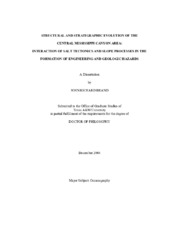| dc.description.abstract | Approximately 720 square miles of digital 3-dimensional seismic data covering
the eastern Mississippi Canyon area, Gulf of Mexico, continental shelf was used to
examine the structural and stratigraphic evolution of the geology in the study area. The
analysis focused on salt tectonics and sequence stratigraphy to develop a geologic model
for the study area and its potential impact on engineering and geologic hazards.
Salt in the study area was found to be established structural end-members derived
from shallow-emplaced salt sheets. The transition from regional to local salt tectonics
was identified through structural deformation of the stratigraphic section on the seismic
data and occurred no later than ~450,000 years ago. From ~450,000 years to present,
slope depositional processes have become the dominant geologic process in the study
area.
Six stratigraphic sequences (I-VI) were identified in the study area and found to
correlate with sequences previously defined for the Eastern Mississippi Fan. Condensed
sections were the key to the correlation. The sequence stratigraphy for the Eastern
Mississippi Fan can be extended ~28 miles west, adding another ~720 square miles to
the interpreted Fan.
A previously defined channel within the Eastern Fan was identified in the study
area and extended the channel ~28 miles west. Previous work on the Eastern Fan
identified the source of the Fan to be the Mobile River; however, extending the channel
west suggests the sediment source to be from the Mississippi River, not the Mobile
River. Further evidence for this was found in ponded turbidites whose source has been
previously established as the Mississippi River.
Ages of the stratigraphic sequences were compared to changes in eustatic sea
level. The formation stratigraphic sequences appear decoupled from sea level change
with ?pseudo-highstands? forming condensed sections during pronounced Pleistocene
sea level lowstands. Miocene and Pleistocene depositional analogues suggest the
location of the shifting Mississippi River Pleistocene depocenter is a more dominant
influence on sequence formation. Thus, the application of traditional sequence
interpretation with respect to sea level change should be reconsidered to also account for
the shifting depocenter for both the study area as well as the broader Eastern Mississippi
Fan. | en |


